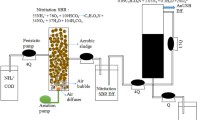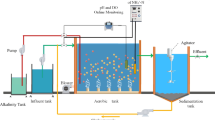Abstract
This study successfully achieved stable nitritation by adding hydrogen peroxide (H2O2) to the nitrification sludge whose nitritation stability had been destroyed. The batch experiment demonstrated that, the activity of ammonia-oxidizing bacteria (AOB) was restored more rapidly than that of nitrite oxidizing bacteria (NOB) after the addition of H2O2, thereby selectively promoting AOB enrichment and NOB washout. When the H2O2 concentration was 6.25 mg/L, the NOB activity was significantly reduced and the nitrite accumulation rate (NAR) was more than 95% after 18 cycles of nitrifying sludge restoration. As a result, H2O2 treatment enabled a nitrifying reactor to recover stable nitritation performance via H2O2 treatment, with the NAR and ammonia removal efficiency (ARE) both exceeding 90%. High-throughput sequencing analysis revealed that H2O2 treatment was successful in restoring nitritation, as the relative abundance of Nitrosomonas in the nitrifying reactor increased from 6.43% to 41.97%, and that of Nitrolancea decreased from 17.34% to 2.37%. Recovering nitritation by H2O2 inhibition is a low operational cost, high efficiency, and non-secondary pollution nitritation performance stabilization method. By leveraging the varying inhibition degrees of H2O2 on AOB and NOB, stable nitrification can be efficiently restored at a low cost and without causing secondary pollution.






Similar content being viewed by others
References
Belser LW, Mays EL (1980) Specific inhibition of nitrite oxidation by chlorate and its use in assessing nitrification in soils and sediments. Appl Environ Microb 39(3):505–510. https://doi.org/10.1128/aem.39.3.505-510.1980
Chen J, Liu X, Pavlostathis SG (2021) Long-term evaluation of the effect of peracetic acid on a mixed aerobic culture: Organic matter degradation, nitrification, and microbial community structure. Water Res (Oxford) 190:116694. https://doi.org/10.1016/j.watres.2020.116694
Chen J, Pavlostathis SG (2022) Evaluation of the effect of peracetic acid solution on the performance of a continuous-flow biological nitrogen removal (BNR) system. Chem Eng J (Lausanne, Switzerland : 1996) 431:133340. https://doi.org/10.1016/j.cej.2021.133340
Chen J, Song T, Long S, Zhu KJ, Pavlostathis SG (2022) Effect of peracetic acid solution on a nitrifying culture: Kinetics, inhibition, cellular and transcriptional responses. Water Res 219:118543. https://doi.org/10.1016/j.watres.2022.118543
Chen J, Wang R, Wang X, Chen Z, Feng X, Qin M (2019b) Response of nitritation performance and microbial community structure in sequencing biofilm batch reactors filled with different zeolite and alkalinity ratio. Bioresource Technol 273:487–495. https://doi.org/10.1016/j.biortech.2018.11.020
Chen X, Wang X, Chen X, Zhong Z, Chen Z, Chen J, Jiang Y (2019a) Salt inhibition on partial nitritation performance of ammonium-rich saline wastewater in the zeolite biological aerated filter. Bioresource Technol 280:287–294. https://doi.org/10.1016/j.biortech.2019.02.048
Chen Z, Wang X, Chen X, Chen J, Feng X, Peng X (2018) Nitrogen removal via nitritation pathway for low-strength ammonium wastewater by adsorption, biological desorption and denitrification. Bioresource Technol 267:541–549. https://doi.org/10.1016/j.biortech.2018.07.084
Chen Z, Wang X, Yang Y, Mirino MW, Yuan Y (2016) Partial nitrification and denitrification of mature landfill leachate using a pilot-scale continuous activated sludge process at low dissolved oxygen. Bioresource Technol 218:580–588. https://doi.org/10.1016/j.biortech.2016.07.008
Ding F, Liang D, Wu Y, Li D, Bian W, Li J (2020) Effect of C/N on partial nitrification in an MBBR at low temperature. Environ Sci: Water Res Technol 6(12):3391–3399. https://doi.org/10.1039/D0EW00654H
Duan H, Ye L, Lu X, Yuan Z (2019) Overcoming Nitrite Oxidizing Bacteria Adaptation through Alternating Sludge Treatment with Free Nitrous Acid and Free Ammonia. Environ Sci Technol 53(4):1937–1946. https://doi.org/10.1021/acs.est.8b06148
Eaton A. (2005). Standards methods for the examination of water and wastewater.
Eilersen AM, Henze M, Kløft L (1994) Effect of volatile fatty acids and trimethylamine on nitrification in activated sludge. Water Res 28(6):1329–1336. https://doi.org/10.1016/0043-1354(94)90298-4
Erguder TH, Boon N, Vlaeminck SE, Verstraete W (2008) Partial Nitrification Achieved by Pulse Sulfide Doses in a Sequential Batch Reactor. Environ Sci Technol 42(23):8715–8720. https://doi.org/10.1021/es801391u
Ge S, Wang S, Yang X, Qiu S, Li B, Peng Y (2015) Detection of nitrifiers and evaluation of partial nitrification for wastewater treatment: A review. Chemosphere 140:85–98. https://doi.org/10.1016/j.chemosphere.2015.02.004
Gilbert EM, Agrawal S, Brunner F, Schwartz T, Horn H, Lackner S (2014) Response of DifferentNitrospira Species To Anoxic Periods Depends on Operational DO. Environ Sci Technol 48(5):2934–2941. https://doi.org/10.1021/es404992g
Gu J, Yang Q, Liu Y (2018) Mainstream anammox in a novel A-2B process for energy-efficient municipal wastewater treatment with minimized sludge production. Water Res 138:1–6. https://doi.org/10.1016/j.watres.2018.02.051
Holmes DE, Dang Y, Smith JA (2019) Nitrogen cycling during wastewater treatment. Adv Appl Microbiol 106:113–192. https://doi.org/10.1016/bs.aambs.2018.10.003
Huang X, Urata K, Wei Q, Yamashita Y, Hama T, Kawagoshi Y (2016) Fast start-up of partial nitritation as pre-treatment for anammox in membrane bioreactor. Biochem Eng J 105:371–378. https://doi.org/10.1016/j.bej.2015.10.018
Juliastuti SR, Baeyens J, Creemers C, Bixio D, Lodewyckx E (2003) The inhibitory effects of heavy metals and organic compounds on the net maximum specific growth rate of the autotrophic biomass in activated sludge. J Hazard Mater 100(1-3):271–283. https://doi.org/10.1016/S0304-3894(03)00116-X
König RB, Furtado PS, Wasielesky W, Abreu PC (2021) Effect of hydrogen peroxide on the microbial community present in biofloc production systems of the shrimp Litopenaeus vannamei. Aquaculture 533:736155. https://doi.org/10.1016/j.aquaculture.2020.736155
Larriba O, Rovira-Cal E, Juznic-Zonta Z, Guisasola A, Baeza JA (2020) Evaluation of the integration of P recovery, polyhydroxyalkanoate production and short cut nitrogen removal in a mainstream wastewater treatment process. Water Res 172:115474. https://doi.org/10.1016/j.watres.2020.115474
Li J, Elliott D, Nielsen M, Healy MG, Zhan X (2011) Long-term partial nitrification in an intermittently aerated sequencing batch reactor (SBR) treating ammonium-rich wastewater under controlled oxygen-limited conditions. Biochem Eng J 55(3):215–222. https://doi.org/10.1016/j.bej.2011.05.002
Marcelino M, Guisasola A, Baeza JA (2009) Dynamic peroxide method for k L a O 2 estimation. J Chem Technol Biotechnol (1986) 84(8):1104–1110. https://doi.org/10.1002/jctb.2138
Miao Y, Zhang L, Yang Y, Peng Y, Li B, Wang S, Zhang Q (2016) Start-up of single-stage partial nitrification-anammox process treating low-strength swage and its restoration from nitrate accumulation. Bioresource Technol 218:771–779. https://doi.org/10.1016/j.biortech.2016.06.125
Park S, Bae W (2009) Modeling kinetics of ammonium oxidation and nitrite oxidation under simultaneous inhibition by free ammonia and free nitrous acid. Process Biochem 44(6):631–640. https://doi.org/10.1016/j.procbio.2009.02.002
Pedersen L, Pedersen PB (2012) Hydrogen peroxide application to a commercial recirculating aquaculture system. Aquacult Eng 46:40–46. https://doi.org/10.1016/j.aquaeng.2011.11.001
Pedersen LF, Good CM, Pedersen PB (2012) Low-Dose Hydrogen Peroxide Application in Closed Recirculating Aquaculture Systems. N Am J Aquacult 74(1):100–106. https://doi.org/10.1080/15222055.2011.651562
Peng Y, Zhu G (2006) Biological nitrogen removal with nitrification and denitrification via nitrite pathway. Appl Microbiol Biot 73(1):15–26. https://doi.org/10.1007/s00253-006-0534-z
Ren S, Wang Z, Jiang H, Qiu J, Li X, Zhang Q, Peng Y (2021) Stable nitritation of mature landfill leachate via in-situ selective inhibition by free nitrous acid. Bioresource Technol 340:125647. https://doi.org/10.1016/j.biortech.2021.125647
Schwartz MF, Bullock GL, Hankins JA, Summerfelt ST, Mathias JA (2000) Effects of Selected Chemotherapeutants on Nitrification in Fluidized-Sand Bioftlters for Coldwater Fish Production. Int J Recirc Aquac 1(1). https://doi.org/10.21061/ijra.v1i1.1362
Soliman M, Eldyasti A (2018) Ammonia-Oxidizing Bacteria (AOB): opportunities and applications—a review. Rev Environ Sci Bio/Technol 17(2):285–321. https://doi.org/10.1007/s11157-018-9463-4
Sun H, Peng Y, Wang S, Ma J (2015) Achieving nitritation at low temperatures using free ammonia inhibition on Nitrobacter and real-time control in an SBR treating landfill leachate. J Environ Sci 30:157–163. https://doi.org/10.1016/j.jes.2014.09.029
Wang B, Wang Z, Wang S, Qiao X, Gong X, Gong Q, Liu X, Peng Y (2020) Recovering partial nitritation in a PN/A system during mainstream wastewater treatment by reviving AOB activity after thoroughly inhibiting AOB and NOB with free nitrous acid. Environ Int 139:105684. https://doi.org/10.1016/j.envint.2020.105684
Wang F, Xu S, Liu L, Wang S, Ji M (2021) One-stage partial nitrification and anammox process in a sequencing batch biofilm reactor: Start-up, nitrogen removal performance and bacterial community dynamics in response to temperature. Sci Total Environ 772:145529. https://doi.org/10.1016/j.scitotenv.2021.145529
Wei D, Xue X, Yan L, Sun M, Zhang G, Shi L, Du B (2014) Effect of influent ammonium concentration on the shift of full nitritation to partial nitrification in a sequencing batch reactor at ambient temperature. Chem Eng J (Lausanne Switzerland : 1996) 235:19–26. https://doi.org/10.1016/j.cej.2013.09.005
Xu G, Xu X, Yang F, Liu S (2011) Selective inhibition of nitrite oxidation by chlorate dosing in aerobic granules. J Hazard Mater 185(1):249–254. https://doi.org/10.1016/j.jhazmat.2010.09.025
Xu G, Xu X, Yang F, Liu S, Gao Y (2012) Partial nitrification adjusted by hydroxylamine in aerobic granules under high DO and ambient temperature and subsequent Anammox for low C/N wastewater treatment. Chem Eng J 213:338–345. https://doi.org/10.1016/j.cej.2012.10.014
Yang S, Yang F (2011) Nitrogen removal via short-cut simultaneous nitrification and denitrification in an intermittently aerated moving bed membrane bioreactor. J Hazard Mater 195:318–323. https://doi.org/10.1016/j.jhazmat.2011.08.045
Yang Y, Chen Z, Wang X, Zheng L, Gu X (2017) Partial nitrification performance and mechanism of zeolite biological aerated filter for ammonium wastewater treatment. Bioresource Technol 241:473–481. https://doi.org/10.1016/j.biortech.2017.05.151
Zeng W, Li L, Yang Y, Wang S, Peng Y (2010) Nitritation and denitritation of domestic wastewater using a continuous anaerobic–anoxic–aerobic (A2O) process at ambient temperatures. Bioresource Technol 101(21):8074–8082. https://doi.org/10.1016/j.biortech.2010.05.098
Zhang L, Fan J, Nguyen HN, Li S, Rodrigues DF (2019) Effect of cadmium on the performance of partial nitrification using sequencing batch reactor. Chemosphere 222:913–922. https://doi.org/10.1016/j.chemosphere.2019.02.006
Zhang X, Wu P, Ma L, Chen J, Wang C, Liu W, Xu L (2021) A novel simultaneous partial nitrification and denitratation (SPND) process in single micro-aerobic sequencing batch reactor for stable nitrite accumulation under ambient temperature. Chem Eng J 425:130646. https://doi.org/10.1016/j.cej.2021.130646
Zhang Z, Zhang Y, Chen Y (2020) Recent advances in partial denitrification in biological nitrogen removal: From enrichment to application. Bioresource Technol 298:122444. https://doi.org/10.1016/j.biortech.2019.122444
Acknowledgments
This work was financially supported by National Natural Science Foundation of China (52300087) and 2023 Guangzhou Basic Research Program Basic and Applied Basic Research Project (2023A04J0912). The authors are grateful to all the people who helped complete this research and to the anonymous reviewers for their suggestions for improving the manuscript.
Funding
This work was financially supported by National Natural Science Foundation of China (52300087) and 2023 Guangzhou Basic Research Program Basic and Applied Basic Research Project (2023A04J0912).
Author information
Authors and Affiliations
Contributions
Cuilan Deng: Conceptualization, Methodology, Writing original draf, Investigation. Zhenguo Chen: Writing review & editing, Supervision. Yonggan Li: Investigation. Haochuan Chen: Data curation. Yongxing Chen: Writing review & editing. Songwei Zhou: Writing review & editing. Rong Niu: Writing review & editing. Yuemin Tan: Writing review & editing.
Corresponding author
Ethics declarations
Ethical approval
Not applicable.
Consent to participate
All authors of this paper consent to participate.
Consent for publication
All authors of this manuscript have consented to its publication.
Competing interest
The authors declare no competing interests.
Additional information
Responsible Editor: Gerald Thouand
Publisher’s Note
Springer Nature remains neutral with regard to jurisdictional claims in published maps and institutional affiliations.
Rights and permissions
Springer Nature or its licensor (e.g. a society or other partner) holds exclusive rights to this article under a publishing agreement with the author(s) or other rightsholder(s); author self-archiving of the accepted manuscript version of this article is solely governed by the terms of such publishing agreement and applicable law.
About this article
Cite this article
Deng, C., Chen, Z., Li, Y. et al. Effective recovery of the nitritation process through hydrogen peroxide. Environ Sci Pollut Res (2024). https://doi.org/10.1007/s11356-024-33056-9
Received:
Accepted:
Published:
DOI: https://doi.org/10.1007/s11356-024-33056-9




